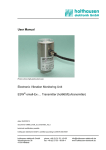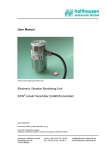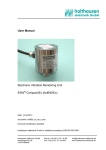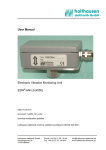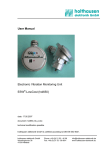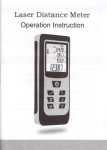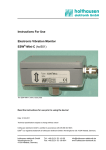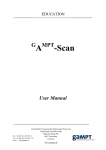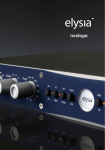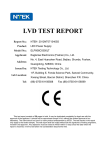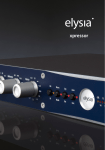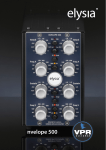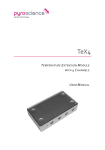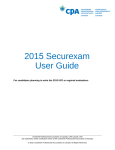Download Small-Compact (hol601) Manual
Transcript
holthausen elektronik GmbH User Manual Picture shows Aluminium-case without ground on earth terminal Electronic Vibration Monitoring Unit ESW®-small-Compact (hol601) date: 22.07.2009 document: hol601_small_comp_hb_e.doc technical modification possible holthausen elektronik GmbH is certified according to DIN EN ISO 9001 holthausen elektronik GmbH Wevelinghoven 38 41334 Nettetal phone: +49 (0) 21 53 - 40 08 fax: +49 (0) 21 53 - 89 99 4 [email protected] www.holthausen-elektronik.de holthausen Electronic Vibration monitoring Unit ESW®-small-Compact elektronik GmbH Table of Contents 1. Generally basical safety-indications ............................ page 4 2. Packing and the transport ........................................... page 4 3. Application................................................................... page 5 4. Measurement principle ................................................ page 5 5. Grounding concept ...................................................... page 6 6. Mounting of the vibration control unit .......................... page 7 7. Opening and closing of the vibration control unit......... page 8 8. Maintenance................................................................ page 8 9. Display- and operation- elements................................ page 9 10. Measurement range switching .................................... page 10 11. Analog output .............................................................. page 10 12. Possible ground configurations ................................... page 10 13. Analog output settings ................................................. page 11 14. Adjustment of the limiting values ................................. page 11 15. Example to adjust the limit value ................................. page 12 16. Optional alarm memory ............................................... page 12 17. Self test ....................................................................... page 12 17.1 Automatic self-test in the background ............... page 13 17.2 Selt-test called externally by the user ............... page 13 17.3 Self-test on starting (optional) ........................... page 14 18. Housing size................................................................ page 15 19. Cable connection draft ................................................ page 16 Declaration of Conformity ............................................ page 17 Technical Data ............................................................ appendix 2 holthausen Electronic Vibration monitoring Unit ESW®-small-Compact elektronik GmbH Important information These operation instructions are to be read through completely and carefully heeded before starting the device. Failure to heed or adhere can result in claims on manufacturer’s liability becoming null and void for damages ensuing there from. Manual action of any manner on the device – with the exception of proper procedures and those described in these operation instructions – lead to forfeit of guarantee and exclusion from liability. The device is solely intended for the usage as described below. It is particularly not intended for the direct or indirect protection of persons. holthausen elektronik GmbH assumes no liability whatsoever as regards suitability for some specific purpose. If any question should remain open, please never hesitate to contact us. holthausen elektronik GmbH Wevelinghoven 38, 41334 Nettetal Phone: +49 (0) 21 53 - 40 08 Fax: +49 (0) 21 53 - 8 99 94 Mail: [email protected] 3 holthausen Electronic Vibration monitoring Unit ESW®-small-Compact elektronik GmbH 1. Generally basical safety-indications Don’t use this device as the only invigilator, if a malfunctioning of ESW ®-small-Compact could lead to damages on goods or Persons. To obtain the desired result be sure, that the device with its technical data fits to the bulk of the object you want to supervise. The sensor is sensitive to shock. A downfall out lower height to a hard substratum can destroy the sensor. The assembling place and the execution of the assembling of the sensor determine decisively the quality of the sensor signal. The assembling may only happen through qualified and instructed persons. The electrical hook up is to be done by instructed persons. A mistake by the connection can entail to faulty functions, outfall or ruination of the sensor and electronics. The ESW ® should not be used on machines with a very energetic high-frequency solidborne. Through resonance apparitions in the sensor, the device can indicate a much too great or too small value. Powerful noise sources for instance inverters, in direct closeness of the sensor, electronics or cabling, can result in faulty behaving of the apparatus. Potential differences and balance currents in the mass guidance can result in faulty behaving too. The connection cable is resistant against many but not every type of chemical and mechanical stress. Through a damaged cable chemicals could get inside the unit and destroy the electronic. Then the unit would loose their function. Therefore the conditions from the mounting surrounding must be checked. Then the cover material from the cable have to be proofed if it resists these requirements. You can get an overview from the chemical resistance of the cover material from us. 2. Packing and the transport Note: • The sensor is sensitive to shock. A downfall out lower height to an hard substratum can destroy the sensor. • Avoid to kink or tie a knot in the cable. • Keep the electronic in a dry place. • In case of a downfall or heckling or squeezing, could the casing or the operation elements or the board get defects. With adequate warning-labels and through a qualified packaging and storage, you can protect the sensor and electronics at carriage against influences from outside. 4 holthausen Electronic Vibration monitoring Unit ESW®-small-Compact elektronik GmbH 3. Application The ESW ®-small-Compact unit will be installed on machines like ventilators, blasts, separators or decanters in order to protect these machines in the application against inadmissible mechanical vibration. The unit monitor continuously the intensity of vibration and warn reliably during exceeding of, inside the unit, adjusted limit values. Moreover it is always possible to measure the actual vibration value at the analog output. The permanent temperatur monitoring inside the case also is a feature of this unit (see 18.1). 4. Measurement principle The sensor converts mechanical oscillations into an electrical alternating voltage. The subsequent electronics converts the AC signal into a DC voltage, which is equivalent to the measured oscillation speed. The sensitivity, and thus the measuring range, can be selected in the device using a switch. The electronics compares the measured value with two threshold values G1 and G2, which can be set in the device using two potentiometers. The threshold values can be steplessly set between 10% and 100% of the possible measuring range. The analog output can be used as an aid for adjustment when setting the threshold values G1 and G2. If the measured value crosses a threshold value the corresponding alarm relay is switched after the expiry of a permanently set response delay period. If the measured value falls below the threshold value the alarm is cancelled after the expiry of the release delay period. The response delay and the release delay depend on the version (see specific data sheet) and can lie between 0.2s and 25s (fixed by factory). Alternatively the device can also be equipped with alarm memory (see Point 16). In addition, the measured value controls a constant current source. A current in the range 0 to 20mA or 4 to 20mA which is proportional to the measured value and corresponds to the measuring range is delivered over the “analog output” cable terminals. All important electronic components of the device can be checked using the self-test functions of the device (Point 18). All important functions are permanently verified in normal operation. The functions such as, e.g., the relay test which would disturb the measuring operation, can be carried out by the user when required the pressing the switch (S1). Optionally the device can be delivered with a self-test on starting. This carries out a complete function test every time the device is switched on (Point 18.3). Attention: Pay attention on requirement by entrance in EEx-Zone 5 holthausen Electronic Vibration monitoring Unit ESW®-small-Compact elektronik GmbH 5. Grounding concept main control box with power supply optional connection box vibration control unit shield shield +Ub -Ub signal ground signal ground vibration control unit ground local vibration control unit ground connection box ground local connection box ground main control box ground local main control box ground If an isolated installation is not specially requested, usually through the attachment with screws each case is connected to the local machine ground. Inside the ESW ®-small-Compact the case potential, the cable shield and the internal signal ground could be connected with each other by choice (see 13). In big facilities with considerable energy consumption and distances between the machines could such big potential difference be build up, that substantial balancing current on the ground network will occur. Dependent on intensity of such currents is arising of interference’s or damaging of the unit the result! Potential differences could also arise on machines, with small distances not clear crossing of ground potential for example painted color or movable parts like suspension mounting. Energetic high frequency interference energy could be added to the measurement signalwire by inductivity or trough capacity that could change the real existing measurement value! In this way, for example parallel going elements could act as coupling-capacitor and winded up grounding cable could act like a cut off choke. Memorize: Earth connection is not the same everywhere! Check the situation Plan the grounding concept Select the facility / realization 6 holthausen Electronic Vibration monitoring Unit ESW®-small-Compact elektronik GmbH 6. Mounting of the vibration control unit - Whole mounting-, connecting- and adjustment-work should be done from qualified personal only! - Protect the ESW®-small-Compact definitely against drop, stroke and other mechanical shock! - The case of the unit must be connected over the attachment or the ground-on-earthTerminal with the potential compensation of the monitored machine. The connection must be extremely low resistive as well as for long time stable. Doing this, take urgent notice to the valid VDE-regulations. SW22 Surface A >18,0 10,0 max. top hole screw locked M10x25 with LOCTITE protection M10 0,03 A >ø55 The ESW ®-small-Compact will be mounted via one threaded pin AM10*25 per DIN 913 on the machine to be monitored. Important 1. Measuring axis has to be coinciding with vibration excitation axis (see case drawing page 17). 2. Take note of the label with instruction notes. 3. The surface has to be plain, clean and free of paint and rust. 4. The tap hole has to be perpendicular to the surface and free of metal-cuttings or other foreign material. Further more the tap hole and the screw have to be free of paint, rust, grease or other isolating components. 5. The grub screw has to be locked with liquid thread protection against unintended loosening. 6. The unit has to be fixed, tight on the surface. 7. The advises to „connection cable“ (page 6), as well as „Opening and closing of the vibration control unit “ (page 9) are absolutely to note. 7 holthausen Electronic Vibration monitoring Unit ESW®-small-Compact elektronik GmbH 7. Opening and closing of the vibration control unit The user must switch off the power supply, before opening the measurement unit. To open the unit the user needs a 0,9mm type of wrench “inbus - key“ and a forehead key with twobore nut, with size of 4mm. The case cover is ensured with a M2 screw. These must be loosened before opening of the case cover, with an “inbus - key”. After adjustment of the unit, please control the position of the DIP-switches Before closing the unit the O-Ring must be examine. You have to insert a new O-Ring (43 x 2mm, LT170 – original spare part) if the old one is brittle, deformed, damaged or already a few month in use. Please pay attention that the thread and the interior room is oil- and dirt- free. Cleaning around and inside the unit should be done only with clean and dry cloth. The closing and the sealing of the unit is done after app. seven pitches of cover-nut thread, and ensured via the M2 screw. Advises for dismantling Before dismantling the measurement unit, the power supply must be switched off. The connection cable has to be loosened from the supporting surface to avoid damaging of the cable. The vibration control unit should be set free via a 22mm wrench key. 8. Maintenance The ESW ®-small-Compact is maintenance free. Tools for case cover opening: 0,9mm type of wrench (Inbus-key) Adjustable forehead key for two bore nut size 4mm Factory: H. Sartorius Nachf. GmbH & Co phone +49 (0) 21 02 / 44 00 - 0 fax +49 (0) 21 02 / 44 00 - 24 8 holthausen Electronic Vibration monitoring Unit ESW®-small-Compact elektronik GmbH 9. Display- and operation- elements The display and operating elements will be accessible after unscrewing the cover of the ESW ®-small-Compact. Display elements LED1 yellow flashes Limit value G1 exceeded or adjust Limit value K1 yellow on Limit value G1 exceeded longer than the rise time, K1 has switched LED2 red flashes Limit value G2 exceeded or adjust Limit value K2 red on Limit value G1 exceeded longer than the rise time, K2 has switched LED3 green on Operating voltage “on“ green flashes Self test “active“ or error code signal LED3 LED1 LED2 P1 P2 1 2 3 4 5 6 S On J1,J2 Operating elements P1 P2 Potentiometer for setting Limit value G1 Potentiometer for setting Limit value G2 10 bis 100% 10 bis 100% S1 Self test inactive Self test activated OFF ON S2 Analog output corresponds to measured value Set-Mode (Analog output corresponds to limit value) OFF ON S3 switcher for the choice of the Limit values Analog output corresponds to adjust Limit value G1 Analog output corresponds to adjust Limit value G2 OFF ON S4 Analog output 4 to 20mA 0 to 20mA OFF ON S5, S6 measuring range adjustment (see chapter 11) J1, J2 ground- adjustment (see chapter 13) 9 holthausen Electronic Vibration monitoring Unit ESW®-small-Compact elektronik GmbH Setting instructions The following points apply for devices with optional “self-test on starting”: After applying the operating voltage the device starts a complete function test. The green LED3 flashes during the function test (see 18.3). After the function test the relays switches - the switching contacts are closed thereafter. 10. Setting instructions The unit has three measurement ranges, which can be selected by the switches S5 and S6. For the device to operate properly, both the switches should not be in “ON” position, since a non-specified measuring range would then be set. Meaduring range Switch Position 10mm/s 20mm/s 50mm/s S5 OFF OFF ON LED3 S6 OFF ON OFF LED1 LED2 P1 P2 1 2 3 4 5 6 S On J1,J2 11. Analog output As the output value will be submitted constant current, by voting 0 to 20mA or 4 to 20mA. The selection occurs by switching over of switch S4. An output current of 20mA meets the 100%-value of the selected measurement range. In the setting of 0 to 20mA is the valid relation 0.2mA per %, in the setting of 4 to 20mA is the valid relation 4mA + (0.16mA per %). Output range Switch position 0 bis 20mA 4 bis 20mA S4 ON OFF 12. Possible ground configurations By using the jumper J1 and J2 the case potential, cable shield and the internal signal ground could be connected with each other by choice. shield shield case int. GND J1 10 J2 holthausen Electronic Vibration monitoring Unit ESW®-small-Compact elektronik GmbH 13. Analog output settings The 0 to 20mA output can be used for displaying of several values on the analog output. With the standard setting (S2=OFF) the output current corresponds to the measured signal. For example, an analog current value of 20mA corresponds to a measured vibration velocity that has reached 100% of the measuring range set. Important: By switching (S2=ON) the analog output can be used for setting or reading of the limit values G1 and G2. The limit value adjustment means a current of 20mA, so that the switch level close to 100% of the adjusted measurement range. Output Variable Switch Position Limit value G1 Limit value G2 S3 OFF ON LED3 LED1 LED2 P1 P2 1 2 3 4 5 6 S On J1,J2 14. Adjustment of the limiting values If the measuring signal exceeds certain limiting values, the ESW ®-small-Compact shall react by switching potential-free relay contacts. These limit values can be set inside the unit by potentiometers. The limit values can be set between 10% and 100% of the selected measuring range. The limit value G1 will be adjusted with potentiometer P1. Exceeded the value of G1 for longer than the rise time delay for G1, then K1 is switched. The limit value G2 will be adjusted with potentiometer P2. If limit of G2 will be longer than the rise time delay for G2 exceeded, then K2 is switched. Rest the measured value just from time to time over the limit value, so counts the activation delay time after each overstepping of the limit value once more. A short overstepping of the limit values is shown by flashing of the yellow LED for G1 and the red LED for G2. If threshold value 1 is set in the SET mode, the green LED lights up and the yellow LED flashes. If the threshold value 2 is set, the green LED lights up and the red LED flashes. Should e.g. G1 be set to 15mm/s = 30% in the measuring range 50mm/s, then with S3=OFF is set to threshold value G1. Then an output current of 6 mA (= 30% of 20 mA) is set using potentiometer P1. At the analog output, the threshold values are always output with reference to 0-20 mA even if the output current range is set to 4-20 mA. That means, an output current of 2mA (potentiometer at the left stop) means 10% of the measuring range as alarm threshold and 20 mA (potentiometer at the right stop) corresponds to 100% of the measuring range as alarm threshold. For setting the threshold value G2, S3 is set to ON and the same procedure is repeated. After setting the threshold values care should be taken to bring S2 back to “OFF” position in order to start the normal operation again. If the potentiometers are adjusted without bringing S2 into ON position, the device gives an error message. (Protection against unintentional adjustment and defective potentiometers.) 11 holthausen Electronic Vibration monitoring Unit ESW®-small-Compact elektronik GmbH 15. Example to adjust the limit value Analog output 0 to 20mA (10% to 100% = 2mA to 20mA, mean 0.2mA per %) Example: Adjust the limit value G1 to 22.5%, and the limit value G2 to 35%: Measured range 20mm/s S5 S6 OFF ON SET-Mode active S2 ON Balancing of the limit value G1 S3 OFF Set the output current to 4,5mA via P1 (22.5% of 20mA is 4.5mA) SET-Mode active S2 ON Balancing of the limit value G2 S3 ON Set the output current to 7mA via P2 (35% of 20mA is 7mA) Standard-Mode (SET-Modus not active) Measuring variable “vibration velocity“ S2 S3 OFF On oder OFF Self test off S1 OFF 16. Optional alarm memory Additional supply with alarm memory. After the activation of the alarm relay K1 (and/ or K2) the unit will remain in the alarm status until an external and manually reset will be activated. This feature is used in such cases, where the vibration control unit is mounted on unreviewable and difficult accessible places. Through this advanced memory function every alarm is registered. Because of variable mounting of one or more parallel connected reset buttons, it is possible to reset the alarm memory from any place or location. The reset occurs by connection of the external reset contact (violet wire) to ground or +Ub (see specific datasheet). 17. Self-test In order to check the functioning of the ESW ®-small-Compact, self-test functions have been integrated into the device. A large part of the functions is automatically monitored when the device is in operation. Other functions can be checked only manually by pressing the selftest switch, since these would disturb the running operation. 12 holthausen Electronic Vibration monitoring Unit ESW®-small-Compact elektronik GmbH 17.1 Automatic self-test in the background If an error occurs, the green LED flashes one to three times depending on the type of the error, the pre and main contact trips and a fault current of 22mA can be measured at the analog output. Items that are monitored include: • • • • Operating voltage (Error code: LED flashes twice) Temperature (Error code: LED flashes twice) Threshold value potentiometers (must be changed in the set mode only) (Error code: LED flashes once) Sensor (Error code: LED flashes thrice) If the cause of the error is remedied, the device goes back to its normal operation. 17.2 Selt-test called externally by the user The test called by the user consists of 2 parts. The device cannot resume normal measuring operation during the test. The sensitivity of the analog part is checked first. For this purpose, in place of the sensor signal a test signal is fed internally and the measured values are outputted at the analog output. In the event of an error an alarm is outputted at the pre and main contact. Subsequently, the on and release delay times for the pre and main contact are outputted. • The self-test is activated by means of switch (S1) in the device (ON) and is visually indicated by the flashing green LED. The entire test takes a few seconds. • Next, a current of exactly 4 mA must be measurable for 2 s at the analog output. • Later the sensor is disconnected internally and the following analog levels are checked using a test signal. The values measured by the processor are outputted at the analog output. If sensitivity is set to 10mm/s, a current of approx. 16 mA must be outputted for 2 s. If sensitivity is set to 20mm/s, it should be possible to measure approx. 8mA for 2 s followed by 16mA for another 2s at the analog output. If the measuring range is set to 50mm/s, currents of 3.2mA followed by 6.4mA and 16mA are expected at the analog output. If the deviation in the 16mA value is more than 20%, an alarm is outputted. • This is followed by the test for the delay and release periods for the relay. In this test, a current of 22 mA is outputted at the analog output. • Afterwards the two delay periods of the relays expire, which is indicated by the flashing of LEDs (yellow for threshold value 1, red for threshold value 2). • After the expiry of response delay 1 for threshold value 1, relay 1 responds and the yellow diode lights for a time period equal to release delay 1. Then the relay releases again and the LED goes out. 13 holthausen Electronic Vibration monitoring Unit ESW®-small-Compact elektronik GmbH • After the expiry of response delay 2 for threshold value 2, relay 2 responds and the red LED lights for a time period equal to release delay 2. Then the relay releases again and the LED goes out. • After the completion of this test procedure the test is repeated until the switch S1 set to OFF again. Note: In case of short release delay periods (e.g. 0.5 s) the relay switches over “apparently immediately” after responding (after the expiry of the response delay period). If an alarm memory is present for one of the two relays, the system must be reset using an external reset button. Only after doing so, the test procedure starts all over again. This self-test checks that part of the electronics which cannot be monitored in the background. In combination with the automatic tests in the background an unambiguous conclusion regarding the function of the device can be drawn. In the event of an error the relays do not go back to their idle state and the self-test can no more be terminated by resetting S1. In addition, the green LED flashes four times briefly and a fault current of 22mA can be measured at the analog output. The test continues further when the cause of the error is remedied. Function Switch position Self-test ON Self-test OFF S1 ON OFF After execution of the self check the switch S1 must be adjusted OFF “absolutely back to “, in order to ensure a regular function of the ESW ® -small-…Compact. The actual test run is however only terminated. 17.3 Self-test on starting (optional) The tests running automatically in the background and the externally called self-test are run on application of the operating voltage. In the event of an error the relays do not go back to their idle state. During the duration of the test the green LED keeps flashing (it is common to have non-uniform flashing during the changeover period between the individual tests.) The test continues further when the cause of the error is remedied. Caution: if the device has an external RESET, the external RESET output must be actuated to complete the relay test. The normal operation starts after the completion of the test. 14 holthausen Electronic Vibration monitoring Unit ESW®-small-Compact elektronik GmbH 18. Housing size (in mm), with optional ground on earth terminal Case material: Aluminium-, V2A- or V4A 55 mm max. 10mm top hole (M10) ground on earth terminal 4mm² (optional) 15 mm 76 mm 108,0 mm measuring axis picture 1 SW22 30 mm The unit will be mounted via one threaded pin AM10*25 per DIN 913. 15 holthausen Electronic Vibration monitoring Unit ESW®-small-Compact elektronik GmbH 19. Cable connection draft ESW®-small-Compact Version without external reset +24V supply volt. wire color ground analog ground analog output closer contact K1 middle contact K1 opener contact K1 closer contact K2 middle contact K2 opener contact K2 red blue grey yellow green pink white brown black violet : +24V supply voltage : ground : analog output : closer contact K1 : middle contact K1 : opener contact K1 : closer contact K2 : middle contact K2 : opener contact K2 : not connected shield : see page 6 ´Grounding Concept The outlined contacts of the alarm-relays are in position: without supply voltage. Under normal working conditions are the closer- and middle-contacts connected. case The analog signal is measured between analog output (grey) and earth (blue). Version include external reset +24V supply volt. wire color ground opener contact K2 red blue grey yellow green pink white brown black violet external reset shield analog ground analog output closer contact K1 middle contact K1 opener contact K1 closer contact K2 middle contact K2 : +24V supply voltage : ground : analog output : closer contact K1 : middle contact K1 : opener contact K1 : closer contact K2 : middle contact K2 : opener contact K2 : external reset (activ by connection to ground) : see page 6 ´Grounding Concept The outlined contacts of the alarm-relays are in position: without supply voltage. Under normal working conditions are the closer- and middle-contacts connected. case The analog signal is measured between analog output (grey) and earth (blue). ® ESW is a registered trademark of holthausen elektronik GmbH, Wevelinghoven 38, 41334 Nettetal 16 holthausen Electronic Vibration monitoring Unit ESW®-small-Compact elektronik GmbH Declaration of Conformity Application of Directive 2004/108/EC we hereby declare, that the construction of: multifunctional vibration control unit for the vibration supervision ESW®-small-Compact (hol601) complies to the following norms: EN 61000 - 6 - 4 interference emissions EN 61000 - 6 - 2 interference immunity Manufacture holthausen elektronik GmbH Manufacture`s Address Wevelinghoven 38 D - 41334 Nettetal Manager Michael Holthausen Place Date Nettetal 17.05.2007 Signature _______________________ 17

















